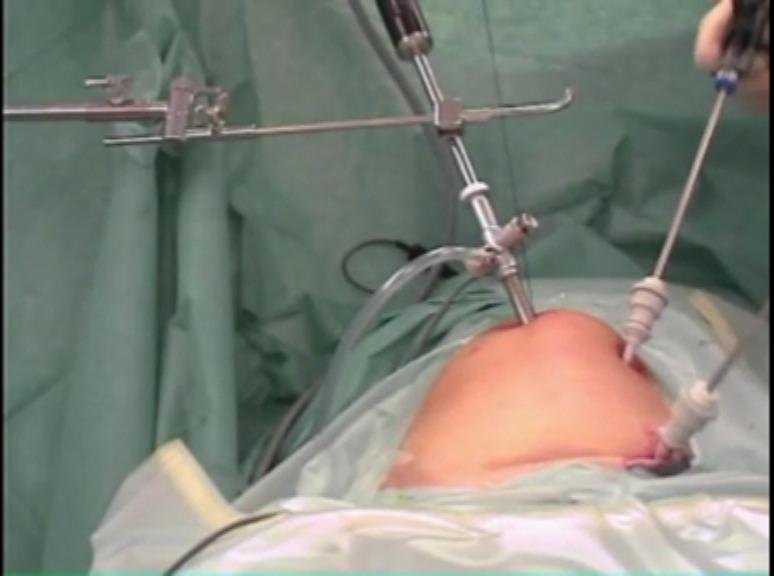
Lift Assisted Laparoscopy and Solo-surgery in Hysterectomy.
FREE FULL TEXT
A mechanical laparoscope holder (stepless motion with one hand, no locking/unlocking mechanism, set-up time < 1 min) replaces an assistant surgeon. Such “solo-surgery” does not slow the surgeon but allows him/her to plan the operation A large uterus is the most commonly reported obstacle to laparoscopic hysterectomy. It reduces the intra-abdominal free space, limits visualization and instrumentation,causes technical difficulties, and increases the potential for complications.The logical solution to this dilemma is to address the underlying problem and increase the intra-abdominal free space. This can be done readily by supplementing the conventional pneumoperitoneum by concurrent mechanical lifting of the abdominal wall using the camera trocar as an anchoring device.Such lift-assisted laparoscopy augments the intra-abdominal free space formation, and lifts the laparoscope to a higher position to give a panoramic view, even when the uterus is large. The camera trocar/abdominal wall complex is lifted with a loop of polydioxanone suture(PDS # 1) snared around the shaft of the trocar with a hang knot and needle-driven through the fascia, cutaneous tissue and skin in the lower end of the abdominal wall incision. The loop suture is attached to a horizontal metal arm mounted on the operating table and placed above the woman. Lifting the skin and the subcutaneous tissue 6–8 cm above the symphysis pubis using a towel clamp further expands the intra-abdominal free space (not shown in the picture). Using an ordinary anesthesia frame in the lifting process, with the horizontal arm draped in a sterile sleeve, makes the procedure progress smoothly. The benefits of the mechanical lifting procedure cannot be overestimated. In combination with standard gas pressure, it augments the intra-abdominal free space, lifts the abdominal wall/camera trocar complex to a higher position, gives a panoramic view, even when the uterus is large and the abdominal wall is thick, and fixes the trocar to the abdominal wall so that there is no trocar sliding or gas leakage.Lift-assisted laparoscopy is an option for improving patient care by modifying surgical procedures. In high-riskpatients, surgery under low gas pressure is possible with a sustained adequate view, and, if necessary, this procedure allows the surgeon to take temporary measures under “gasless” conditions. A special slit-trocar facilitates the shifting maneuver between the gas-based and gasless technique and vice versa. Because the abdominal wall is lifted to a higher position, the camera trocar is preferably placed in or above the umbilicus. This ensures that the slope of the laparoscope does not become too steep and positions the camera trocar more cephalically to permit better inspection of a uterus that reaches the umbilicus.The mechanical lifting procedure introduces no extra devices into the peritoneal cavity, causes no trauma to the peritoneal surface, and does not interfere with surgical movement. The set-up time for camera trocar lifting is less than 1–2 min. A 54 s video of the procedure is available at:(www.youtube.com/watch?v=1eEBFzbmeUY). Lift-assisted laparoscopy improves patient care by modifying surgical procedures that would otherwise, for some surgeons, require laparotomy. Robot-assisted laparoscopy is another technique that addresses the problems that arise when visualization or instrumentation is difficult.The surgeon is seated alone ("solo-surgery") at a console, a few meters from the patient, and controls two specialized robot-assisted instruments and a 3D camera. Two staff members stand next to the patient and assist the robot. -------- ‘Yesterdays’ gasless laparoscopy must not be confused with lift assisted laparoscopy. The European Association for Endoscopic Surgery states that ‘gasless laparoscopy has no clinically relevant advantages compared to low-pressure (5–7 mm Hg) pneumoperitoneum’. There may be two exceptions to this: laparoscopy under local anesthesia and lift-assisted laparoscopy under general anesthesia if it is required to use a conventional open surgery instrument. Lifting of the skin and the subcutaneous tissue 6–8 cm above the symphysis pubis, using a towel clamp,further improves the intra-abdominal space formation. Carbon dioxide gas has a negative effect on cardiovascular and respiratory functions and provokes hypothermia, desiccation, and tissue irritation by acid fluids, and acid–base and blood gas changes. Using low gas pressure minimizes these drawbacks and reduces the frequency and intensity of shoulder tip pain following laparoscopic surgery (2). Temporary zero-pressure gas procedures facilitate the operation and reduce the risk for peroperative conversion to laparotomy. All patients benefit from low-pressure gas laparoscopy and especially high-risk patients, including pregnant women.
Ref: Lift assisted laparoscopy in hysterectomy. A retrospective study of 32consecutive cases. Bergström Bo S. ISRN Minimally invasive surgery. Volume 2013(2013), Article ID 989727, 4 pages FREE FULL TEXT
Ref: Camera trocar lifting in office gasless laparoscopic sterilization underlocal anesthesia. Bergström Bo S. Acta Obstetricia et GynecologicaScandinavica, July 2010, Vol. 89, No. 7, Pages 975-979. FREEFULL TEXT
1. Yaghoobi Notash A, Bahrpeyma SH, Modaghegh MH. Effectiveness of abdominal wall elevator in reducing intra-abdominal pressure and CO2 volume during laparoscopic cholecystectomy. Acta Med Iranica. 2004;42:131–3.
2. Gurusamy KS, Samraj K, Davidson BR. Low pressure versus standard pressure pneumoperitoneum in laparoscopic cholecystectomy. Cochrane Database of Systematic Reviews 2009, Issue 2. Art. No.: CD006930. DOI: 10.1002/14651858.CD006930.pub2
Simplicity & Quality
|